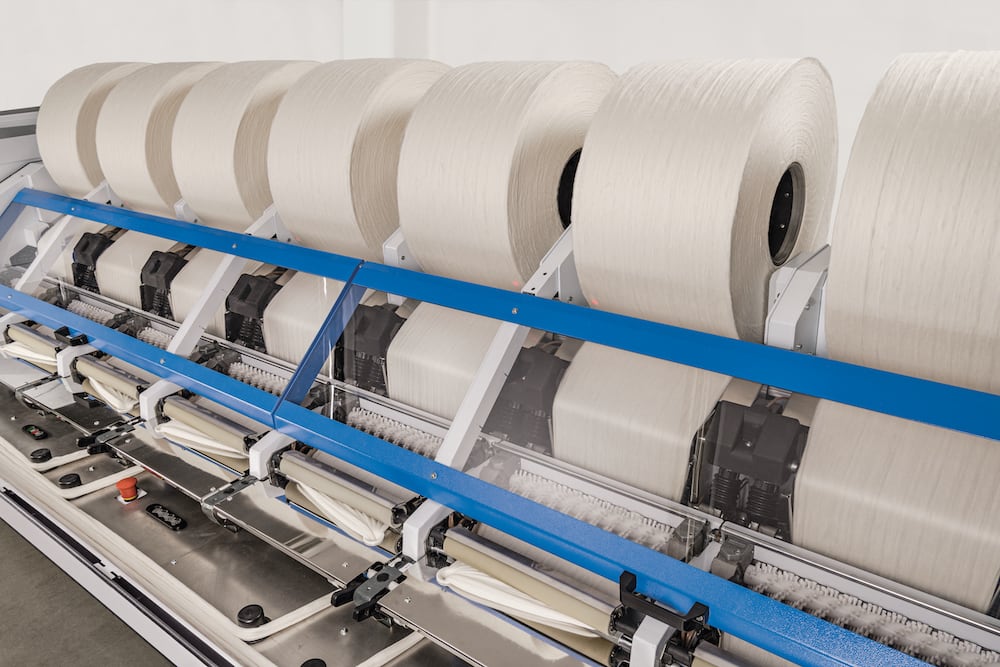Life isn’t easy for yarn producers. They need to improve raw material utilization. They need to boost productivity while balancing between quality and economy.
They need to increase yarn quality to fulfill customer requirements. And they need to do it in combed applications where high-quality standards are essential. Those are some big challenges. The TCO 21 combing machine from Trützschler offers an innovative solution.
Since it was first launched in 2021, the TCO 21 has been delighting customers around the globe with its innovative features and enormous optimization potential. The first large-scale installations are now up and running in the world’s most important combing markets. And the results are extremely positive!
The TCO 21 offers automatic optimization functions and is the first-ever comber to feature 100 % Trützschler technology. That powerful combination is now improving efficiency, productivity and quality in yarn-producing markets worldwide.
Optimized for high-speed combing
The TCO 21 is unique because it features the PIECING OPTIMIZER technology, which reduces fiber stress, especially during high-speed combing. And it works at the push of a single button. This is valuable for yarn producers because the pilger step movement – and the overall acceleration behaviour of the detaching rollers – often acts as a bottleneck when operating at high speeds of up to 600 nips/min. A simple comparison: A detaching roller (48 g) in a high-speed comber accelerates roughly 8 times faster than a formula one car (6 g).
Testing data: High-speed combing
Tests clearly show the potential value offered by the PIECING OPTIMIZER technology for high-speed combing. Technologists examined the level of performance that customers can achieve with a yarn count of Ne 30 made from US cotton.
The number of yarn imperfections remained constant even when increasing the combing speed from 500 to 600 nips/min – which is a 20 % higher production rate. Most important, the amount of noil also remained in the same range for all three trials. In fact, the total number of imperfections in the yarn (measured as IPI) was slightly lower because of fewer thick spots and neps.
Overall, the TCO 21 has demonstrated its capacity to deliver optimal yarn results even when increasing the production rate by up to 20 %.

Testing data: Production increased with a yarn count of Ne 20
Trials have shown that the TCO 21 can achieve a 20 % increase in production output compared to the current combing machine from a competitor for yarn counts of Ne 20 – while also generating less noil. Operating at a rate of 600 nips/min instead of 500 increases yarn production per comber set by around two metric tons per day (depending on the specific settings).
Importantly, the TCO 21 is able to provide this production increase while delivering similar yarn quality in terms of IPI and uniformity – and also reducing noil. The tests show that the TCO 21 can reduce the comber noil by 0.43 % compared to the competitor’s machine.
Testing data: Production increased with a yarn count of Ne 40
The TCO 21 also demonstrated a 20 % production increase and similar yarn quality compared to a competitor’s machine for yarn counts of Ne 40. With a production increase of 10 % – e.g. producing 550 nips/min instead of 500 nips/min – the yarn results improved with the TCO 21.
Furthermore, the number of faults per kilometre only very slightly worsened with a 20 % increase in production. In addition, yarn uniformity remained at the same level in all trials, even when the production rate increased. The comber noils were at the same level too.
Testing data: Production increased with a yarn count of Ne 60
In the final trial, which involved a yarn count of Ne 60, the TCO 21 proved its capacity to achieve a 5 % or 10 % higher production rate with up to 26 % better results for yarn quality. Of course, it is more difficult to improve production rates and maintain quality when working with finer yarns.
But also in this comparison, the TCO 21 demonstrated its excellent performance and advantage compared to the competitor product.
Remarkably, yarn results improved in this test when the production rate for the TCO 21 was increased by 5 % and 10 %. The overall IPI was 21 % and 26 % lower compared to the competition. Despite higher production rates, yarn evenness also remained slightly better than the competitor machine’s level. And the noil was constant across all three production rates that were tested.

Tapping into the full potential of the TCO 21
The results from these tests are extremely positive and we are confident that the unique machine concept has additional potential. Trützschler’s experts are now working side-by-side with our customers to open up new ways of further optimizing the performance of this machine in various application areas.
However, the TCO 21, our first comber with 100 % Trützschler technology, will help our customers improve their competitive position in the global yarn market.
Further visual footage:
The state-of-the-art combing machine TCO 21.
[author title=”About Trützschler:” image=”http://”]The Trützschler Group SE is a German textile machinery manufacturer headquartered in Mönchengladbach, Germany. The company is divided into four business units: Spinning, Nonwovens, Man-Made Fibers, and Card Clothing. Trützschler machines, installations and accessories are produced and developed in ten locations worldwide. This includes four factories in Germany (Dülmen, Egelsbach, Mönchengladbach, Neubulach), as well as sites in China (Jiaxing and Shanghai), India (Ahmedabad), the USA (Charlotte), Brazil (Curitiba) and Switzerland (Winterthur). Service companies in Turkey, Mexico, Uzbekistan and Vietnam and service centres in Pakistan, Bangladesh and Indonesia provide customer proximity in key regions for the textile processing industry. For more information visit: www.truetzschler.com.[/author]



















